Table of Contents
Some links on posts are affiliate links and will earn us a commission from qualifying purchases
When hiking, physical discomfort is an inevitable part of the experience. Whether you’re a seasoned hiker or just starting out, it’s likely you’ll encounter some form of physical discomfort during your hike. This can be due to various factors such as environmental conditions, terrain, or the weight of your backpack.
Knowing the various types of physical discomfort you might encounter while hiking can help you prepare for your trip and take preventive measures to reduce the chances of feeling uncomfortable. By being aware of the possible causes of physical discomfort, you can take steps to minimize their impact and fully enjoy your hike.
Key Takeaways
- Physical discomfort is an expected aspect of hiking.
- Environmental conditions, terrain, and the weight of your backpack can all contribute to physical discomfort.
- Understanding the different types of physical discomfort can help you to prepare for your hike and take preventative measures to minimize discomfort.
Common Types of Physical Discomfort
When hiking, it’s not uncommon to experience physical discomfort. In fact, it’s almost guaranteed that you’ll feel some level of muscle soreness or joint pain at some point during your hike. However, by understanding the common types of physical discomfort, you can take steps to prevent them or manage them if they do occur.
Muscle Fatigue
Muscle fatigue, a frequently experienced physical discomfort during hikes, becomes particularly evident when trekking on steep inclines or carrying a heavy backpack.
To prevent muscle fatigue, it is crucial to gradually enhance your endurance by slowly increasing the intensity and duration of your hikes. Additionally, incorporating strength training exercises into your routine can effectively strengthen your leg muscles, further aiding in the prevention of muscle fatigue.
By implementing these strategies, you can optimize your hiking experience, ensuring a more enjoyable and fulfilling outdoor adventure.
Joint Pain
When hiking, joint pain is a common physical discomfort that can arise due to the repetitive impact on hard surfaces like concrete or rocky terrain.
To prevent such pain, it is important to wear proper footwear that provides good support. Using hiking poles can be beneficial as they help to reduce the impact on your joints, allowing for a more comfortable and enjoyable hiking experience.
Taking these precautions can go a long way in ensuring that your hiking adventures are pain-free and enjoyable.
Foot pain
Foot pain is a common discomfort experienced during hiking adventures. It can be caused by various factors like ill-fitting footwear, blisters, or even plantar fasciitis – a condition where the tissue connecting the heel to the toes gets inflamed.
To prevent foot pain, it’s crucial to prioritize wearing properly fitting shoes or boots that offer great support and cushioning. You can also consider using insoles or orthotics for added support and to ease any discomfort.
Taking proactive measures to avoid foot pain ensures a more enjoyable and pain-free hiking experience.
Blisters and Footwear Issues
When you’re heading out for a hike, it’s pretty common to come across blisters and other footwear-related issues. To steer clear of these discomforts, it’s crucial to wear shoes or boots that fit properly and break them in before you start your adventure.
You could also think about using moleskin or other blister prevention products to give your feet some extra protection. But, if you do end up with a blister, it’s really important to treat it quickly and effectively to avoid any potential infections and make sure your hiking experience stays enjoyable.
Knee pain
When hiking, knee pain is a common issue, especially when going downhill. This usually occurs from overuse or incorrect knee alignment.
To prevent knee pain, it’s important to wear suitable footwear with good support and cushioning. Using hiking poles can also help reduce the impact on your knees, providing extra protection and stability.

Hip pain
Hip pain is another common type of physical discomfort that hikers may experience during their adventures. This discomfort can arise from overuse or improper alignment of the hips.
To effectively prevent hip pain, it is crucial to wear appropriate footwear that provides excellent support and stability.
Also, incorporating hiking poles into your gear can greatly reduce the impact on your hips, allowing for a more enjoyable and pain-free hiking experience.
Back and Shoulder Strain
Back and shoulder strain are common when hiking, especially if you’re carrying a heavy backpack. To prevent back and shoulder strain, it’s important to pack light and to use a backpack with good support. You can also try doing strength training exercises to build up your back and shoulder muscles.
Environmental Factors Causing Discomfort
When hiking, you may experience physical discomfort due to various environmental factors. Here are some of the most common ones:
Dehydration
Dehydration occurs when you lose more fluids than you take in. This can happen when you sweat excessively during a hike and don’t drink enough water to replenish your body. Symptoms of dehydration include thirst, dry mouth, headache, dizziness, and fatigue.
To prevent dehydration, make sure to drink plenty of water before, during, and after your hike. You can also bring electrolyte drinks or tablets to help replace lost minerals.
Sunburn
Exposure to the sun’s UV rays can cause sunburn, which can be painful and uncomfortable. Symptoms of sunburn include redness, swelling, and blistering of the skin.
To prevent sunburn, wear protective clothing such as long-sleeved shirts and hats, and apply sunscreen with a high SPF. Reapply sunscreen every few hours, especially if you are sweating or swimming.
Insect Bites and Stings
Insects such as mosquitoes, ticks, and bees can bite or sting you while hiking, causing discomfort and pain. In some cases, insect bites and stings can also cause allergic reactions.
To prevent insect bites and stings, wear long-sleeved shirts and pants, and use insect repellent. If you do get bitten or stung, remove the stinger if present, and apply ice or a cold compress to reduce swelling.
Overheating
Overheating can occur when your body temperature rises too high, causing symptoms such as dizziness, nausea, and headache. This can happen when hiking in hot and humid weather, or when wearing too many layers of clothing.
To prevent overheating, wear lightweight and breathable clothing, and take breaks in shaded areas. You can also use a cooling towel or a spray bottle to cool down your body temperature.
By staying mindful of these environmental factors and taking the necessary precautions, you can reduce physical discomfort during your hiking adventures.
Terrain-Related Discomfort
When you’re hiking, the terrain can present a number of challenges that can lead to physical discomfort. These discomforts can range from minor aches and pains to more serious injuries. By understanding the types of terrain-related discomfort you may encounter, you can better prepare yourself for your hike and minimize the risk of injury.
Uneven Ground
Hiking on uneven ground can be a challenge for even the most experienced hiker. Uneven ground can cause you to twist your ankle, which can lead to pain, swelling, and difficulty walking. To avoid this discomfort, it’s important to pay close attention to where you’re stepping and to wear boots that provide good ankle support.
Steep Inclines
Hiking up steep inclines can be a real challenge, and it can lead to discomfort in your legs, back, and neck. To minimize this, it’s important to take frequent breaks and to stretch your muscles regularly. You may also want to consider using hiking poles to help distribute your weight more evenly and to take some of the pressure off your legs.
Slippery Surfaces
Hiking on slippery surfaces, such as wet rocks or muddy trails, can be dangerous and can lead to serious injuries. To avoid slipping and falling, wear shoes or boots with good traction and take your time when hiking on slippery surfaces. You may also want to consider using hiking poles to help maintain your balance and to provide extra support.
By being aware of the types of terrain-related discomfort you may encounter when hiking, you can better prepare yourself for your hike and minimize the risk of injury. Remember to wear appropriate footwear, take frequent breaks, and use hiking poles when necessary to help distribute your weight more evenly and to provide extra support.
Load-Related Physical Discomfort
When hiking, your body is subjected to various physical discomforts, including load-related pain. This type of pain is caused by carrying a heavy rucksack or improper distribution of weight. Here are two common causes of load-related physical discomfort:
Excessive Pack Weight
Carrying a heavy rucksack can cause a lot of physical discomfort. The weight of the rucksack can put a lot of pressure on your back, shoulders, and hips. This can cause muscle fatigue, soreness, and even injury.
To avoid excessive pack weight, make sure to only pack the essentials. You should also invest in a lightweight backpack that is specifically designed for hiking. This will help to distribute the weight evenly across your body and reduce the amount of pressure on your back and shoulders.
Improper Load Distribution
Improper load distribution is another common cause of load-related physical discomfort. This happens when the weight of your rucksack is not distributed evenly across your body. This can cause muscle strain and fatigue, and can even lead to injury.
To avoid improper load distribution, make sure to pack your rucksack properly. Heavy items should be placed at the bottom, close to your back. This will help to distribute the weight evenly across your body and reduce the amount of pressure on your back and shoulders. You should also adjust the straps on your rucksack to ensure a comfortable fit.
Preventative Measures and Solutions
When it comes to hiking, it’s essential to take preventative measures to avoid physical discomfort. Here are some solutions to common hiking-related physical discomfort:
Proper Footwear Selection
Wearing the right footwear is crucial when hiking. Invest in a good pair of hiking boots that provide ample support and traction. Make sure they fit well and are broken in before your hike. If you’re prone to blisters, consider wearing moisture-wicking socks and using blister pads.
Use of Walking Poles
Using walking poles can help reduce the impact on your knees and joints. They also help with balance and stability on uneven terrain. Make sure to adjust them to the right height and use them consistently throughout your hike.
Pacing and Rest Breaks
Hiking at a steady pace and taking regular rest breaks can help prevent fatigue and injury. Don’t push yourself too hard, especially if you’re a beginner. Take breaks every 30-60 minutes to stretch, hydrate, and refuel.
By taking these preventative measures and solutions, you can ensure a comfortable and enjoyable hiking experience. Remember to listen to your body and adjust accordingly.
Frequently Asked Questions
What can be done to alleviate knee discomfort experienced during downhill treks?
Experiencing knee discomfort during downhill treks is a common issue that many hikers face. To alleviate this discomfort, give hiking poles a try – they can help distribute your weight and make the descent easier. Remember to take shorter steps and keep your knees slightly bent. Don’t forget to wear proper footwear with good support and cushioning – it’ll help reduce the impact on your knees.
How does one manage extreme leg soreness following a hike?
Extreme leg soreness after a hike can be managed by stretching and massaging the affected muscles. Taking a warm bath or using a heating pad can also help ease soreness. Adequate hydration and nutrition are also important factors in reducing muscle soreness.
Which muscles are typically affected by soreness after a hike?
The muscles that are typically affected by soreness after a hike are the quadriceps, hamstrings, calves, and glutes. These muscles are used extensively during hiking and can become fatigued and sore.
What are the characteristic symptoms of hiker’s knee?
Hiker’s knee is a condition that causes pain around the kneecap. The characteristic symptoms of hiker’s knee include pain when bending or straightening the knee, swelling around the knee, and a grinding sensation when moving the knee.
What measures can be taken to recover from hiker’s knee?
To recover from hiker’s knee, it is important to rest and avoid activities that aggravate the condition. Applying ice to the affected area and taking anti-inflammatory medication can also help reduce pain and swelling. Physical therapy and exercises to strengthen the knee muscles can also aid in recovery.
What are the most prevalent injuries encountered by hikers?
The most prevalent injuries encountered by hikers include ankle sprains, blisters, and muscle strains. It is important to wear appropriate footwear and clothing, stay hydrated, and take breaks when needed to prevent these injuries.
Conclusion – types of physical discomfort
Hiking is a rewarding and challenging activity that can provide many physical and mental health benefits. However, it is important to be aware of the potential types of physical discomfort that can occur while hiking. By taking the necessary precautions and preparing properly, you can minimise your risk of experiencing discomfort and enjoy your hike to the fullest.
Some of the most common types of physical discomfort that hikers may experience include blisters, muscle soreness, and joint pain. To prevent blisters, it is important to wear well-fitting shoes and socks, and to break in new footwear before embarking on a long hike. To alleviate muscle soreness, stretching before and after your hike can be helpful, as well as staying hydrated and taking breaks when needed.
In addition to these physical discomforts, hikers may also experience fatigue, dehydration, and sunburn. To prevent fatigue, it is important to pace yourself and take breaks when needed. Staying hydrated and wearing appropriate clothing and sunscreen can also help prevent dehydration and sunburn.
By being aware of the potential types of physical discomfort that can occur while hiking and taking the necessary precautions, you can have a safe and enjoyable experience.
Recent Posts
Dealing with Physical Discomfort during Walking: Tips and Tricks
Dealing with physical discomfort while walking can be challenging. Whether you're a regular walker or just starting out, experiencing discomfort can be discouraging and hinder your fitness goals. But...
The Ultimate Guide to Navigating Skin Sensitivity as a Hiker
As an avid hiker, you know how exhilarating it is to explore the natural world around us on foot. However, all the exposure to sun, wind, and nature's elements can take a toll on your skin. If you...


